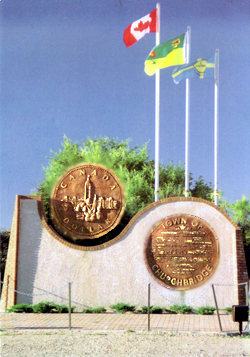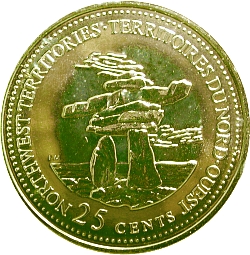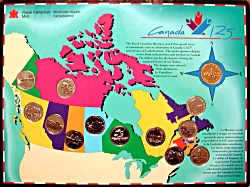By Leon Worden
COINage magazine
November 2005
| T |
|
No, it's not an escapee from a mental institution. It's an oversized effigy of a 1992 Canadian dollar coin. And while it lacks the familiar loon that paddled across the back of the dominion's $1 coin since 1987, it's still a Canadian dollar — so it's still called a loonie.
To the people of Churchbridge, the bronze sculpture of the 1992 loonie is a show of pride, as it was Churchbridge painter Rita Swanson whose artwork was selected for the coin's reverse side in a coast-to-coast-to-coast design contest.
To the citizens of Canada, Swanson's design is a reminder, in her words, "of how lucky we are to live in such a wonderful, unique and very special country." Her rendering of the federal Parliament building on the back of the coin stands as "a testament to our history," she says, while the children in the foreground represent "our future and our source of inspiration."
To a visiting collector of 50-state Washington quarters from south of the border, the monument is a gentle reminder that this is one case where Canada came first. For it wasn't only the $1 coin that Canada redesigned in 1992. Swanson's loonie was the capper to a most ambitious undertaking involving a series of special 25-cent pieces.
Canada issued a dozen different 25-cent pieces in 1992 at the rate of one per month. The perennial caribou design on the back give way to 12 different designs honoring each of Canada's 12 provinces and territories. (Nunavut, now the 13th, was still a part of the Northwest Territories at the time.)
Canada had never issued so many different coins so quickly. But it was worth the effort. This was, after all, Canada's 125th anniversary.
"Coins ... reflect our heritage and foster celebration of the symbols of Canadian identity," said Christine Aquino, spokeswoman for the Royal Canadian Mint. "As such, celebrating the 125th anniversary through coins was a natural fit."
Until it was superseded more than a century later, the Act served as the constitution for the new dominion and set forth a federal government in Ottawa with an elected House of Commons, a lifetime-appointed Senate and a governor-general representing the British crown. Powers not vested in the federal government were relegated to the provinces, which established similar governmental structures.
Canada's coins were made in London until 1908, when the British Royal Mint opened a branch in Ottawa. In 1931 it became a wholly Canadian institution; in 1969, it became a "Crown corporation" — a for-profit, quasi-governmental entity with federal oversight, run by an independent board of directors.
Canada's circulating coinage was rather static throughout that time. Obverse portraiture changed once with each new British monarch and only occasionally as Queen Elizabeth II aged; reverses changed no more frequently. So it was quite a sensation when the Royal Canadian Mint (RCM) changed the reverses of coins in every denomination for the 100th anniversary of confederation in 1967.
That year only, a dove replaced the normal maple leaves on the back of the 1-cent coin; a snowshoe rabbit replaced the beaver on the 5-cent coin; an Atlantic mackerel replaced the sailboat on the 10-cent coin; a lynx replaced the caribou on the 25-cent coin; a howling wolf replaced the shield on the 50-cent coin; and a goose replaced the voyageur (canoe portrait) on the $1 coin. Each reverse design included the dual dates 1867-1967. (The Canadian Mint doesn't use terms such as "dime" and "quarter," just as the U.S. Mint doesn't say "penny" — but regular folks do.)
The 100th-anniversary coins were so popular that government minister Paul Dick, who oversaw the RCM in 1991, announced that the dominion would honor confederation again during the 125th anniversary year of 1992. And this time the Mint would involve the public on the front end.
Entries poured in. They came from schoolchildren and senior citizens, professional artists and doodlers. Some were worthy of framing and hanging on the living-room wall. Some were worthy of cutting out and taping to the refrigerator door. Mint officials say they received 9,277 individual designs in all, including 1,111 for the loonie. Conflicting government records show a total of 11,003 submittals, with 2,871 for the loonie. Either way, they far surpassed the 939 entries received in 1973-74 when Americans were invited to recast the Washington quarter, Kennedy half dollar and Eisenhower dollar for the U.S. bicentennial.
|
Arguably the gem of the series, the rock figure with outstretched "arms" is an inukshuk, a towering, man-like structure built of stones by the Inuit people of the Arctic tundra. Spiritual and functional, inukshuks point the way to shelter, or show the location of a food cache, or mark a family group's territory.
If you place McEachen's inukshuk next to a quarter bearing Bruce Wood's Nova Scotia lighthouse, Mel Heath's Alberta badlands and Muriel E. Hope's Manitoba fortress, you quickly grasp the point of the program: Canada is the sum of some fascinating parts. If you're stateside and don't have access to the Canadian coins, place Rhode Island's sailboat next to Massachusetts' Minuteman, Vermont's maple syrup and Florida's space shuttle, and you'll get the idea.
Canada determined the order for issuing the provincial coins by a random drawing. U.S. 50-state quarters, which came along seven years later, are issued in the order the states signed the Declaration of Independence and later states joined the Union. Canada honored the original-concept artists with their initials on the coins, leaving off the seven Mint engravers who executed the designs; the U.S. Mint credits the only the final sculptor-engraver.
Like those at Denver and Philadelphia, the high-speed presses at the RCM's production facility in Winnipeg are capable of spitting out 750 business strikes per minute. The raised designs of the 1992 coins aren't quite as sharp and the fields aren't as shiny as their Yankee counterparts because Canada crafted them from pure nickel, which doesn't strike up as well as the U.S. clad or "sandwich" composition of 91.67 percent copper and 8.33 percent nickel. (Canada switched to nickel-plated steel planchets in 2000.)
"Nickel is a fairly tough metal," said Del Romines, a tool-and-die expert and retired U.S. military metal fabricator from Louisville, Kentucky, known in numismatic circles as the author of books on hobo nickels.
"When you take our quarter with the copper center, the copper allows the layer of nickel to flow differently from a coin that's totally nickel."
Bottom line, it's harder to sink an impression into solid nickel, and the dies wear out faster, he said. Five-cent U.S. "nickels," he noted, are actually 75-percent copper.
Numismatists weren't to be disappointed, however. Proof versions of the same coins, albeit with a .925-fine silver content (and .075 copper), were sold to collectors. Each proof coin was struck several times with highly polished dies on a low-speed press in Ottawa.
Also like the United States, Canada launched each new coin with a ceremony in the province or territory being honored. Overnight sensations, most coins disappeared from commerce within a year by some estimates, although Canadian Mint officials say the 25-cent pieces still can be found in circulation today.
|
Canada's 1992 coins had educational value, as well. Kids learned geography and fun facts about faraway provinces, and the mint sold maps of Canada with holes for them to fill with 25-cent and $1 coins, just as children across the United States would later do.
Sheer production is the biggest difference between the Canada 125 coins and the U.S. 50-state quarters. Canada is the world's second-biggest country after Russia in terms of landmass, but with just over 32 million people today, its population makes it smaller than California. Canada produced 152.7 million circulating commemorative quarters in 1992 for all provinces and territories, combined; this year, U.S. Mint produced 520.4 million California quarters alone — and California was but one of five states honored in 2005.
So far in the 50-state quarters program, annual business-strike mintages have varied from 2.28 billion coins (2003) to 6.47 billion (2000), with an overall full-year average of 3.94 billion. That's 25.8 times as many quarters each year than Canada produced for its 125th anniversary, while the U.S. population is only nine times larger. Put another way, Canada's production run was so small that if every Canadian saved quarters in 1992, each person would get only five of the 12. For every man, woman and child in America, the U.S. Mint has made, on average, three copies of each state quarter.
Nevertheless, the record reflects that at every stage of "selling" the new U.S. coin program — first to the Citizens Commemorative Coin Advisory Committee where the seeds of the 50-state quarters germinated, then to the Republican-controlled Congress, and finally to hesitant Treasury Democrats — Canada's 1992 series was held up as an example of a comparable program that worked.
"I think that was very helpful," said Rep. Mike Castle, R-Del., whose 1996 legislation created the 50-state quarters. "Coin collectors were citing that."
Castle meant the "coin collectors" who testified in July 1995 before the House Banking Committee's Domestic and International Monetary Policy Subcommittee. Castle had been named subcommittee chairman six months earlier, after the GOP swept the House in the midterm elections. While the nation fussed over House Speaker Newt Gingrich's "Contract With America," Castle wanted to know why the Mint's collector coins weren't selling well. (It was because the Mint was making too many and charging too much; subsequent legislation limited non-circulating commemoratives to two per year.)
One witness at the hearing was New York City coin dealer Harvey Stack, past president of the Professional Numismatists Guild. He suggested, among other things, that the Mint could issue circulating quarters for each of the 13 original colonies, followed by coins for the remaining states.
In subsequent testimony in 1996, when Castle's state-quarter bill was introduced, Stack said: "My idea for a circulating commemorative series was modeled after the Canadian program of a few years ago which honored their 12 provinces (sic) of the dominion. Each coin had a design recognizing the importance of each province." It wasn't a wholly out-of-the-blue notion; prominent coin dealer-author Q. David Bowers had floated the idea of a half-dollar series to honor the U.S. states as early as 1990.
But the real private-sector driver of the 50-state quarters program was longtime COINage Contributing Editor David L. Ganz, who served as president of the American Numismatic Association from 1993 to 1995. In his 1995 congressional testimony, Ganz mentioned Canada as an example of a country that had "utilized the concept of circulating commemorative coinage to great effect." He'd made the point earlier as a member of the Advisory Committee, which was created by Congress in 1993.
In February 1994, he included Canada in a laundry list of countries that had successfully produced circulating commemoratives without jeopardizing sales of collector coins. "On the contrary," Ganz told the Advisory Committee, "it heightened the interest." He also used Canada 125 — as well as the U.S. Bicentennial program — to show the propriety of the 25-cent coin as a medium.
"[Canada 125] certainly was one of many aspects of it," Ganz remembered in a recent interview, while cautioning against overemphasizing any one of several factors that coalesced into the 50-state quarter program.
"Everything kind of came together," echoed Jean Gentry, deputy chief counsel to the U.S. Mint. The deciding factor for the Mint, she said, was the opening of a second die shop, which dramatically boosted production capacity.
Even for Castle, the "Wouldn't it be nice?" arguments didn't fly at first. "I said it sounded like Monopoly money, get out of here," Castle recalled of the 1995 hearing. "So I started out as a doubting Thomas myself. ... At a subsequent meeting they said it would make money."
And they were right. Now two-thirds through, the 50-state quarters have blown all projections of seigniorage out of the water, adding more than $5 billion so far to the nation's Treasury.
Coopers & Lybrand LLP (now part of PricewaterhouseCoopers) and a subcontractor, Opinion Research Corp., were commissioned for the study. They based their conclusions on telephone polling, focus groups in six cities — including two cities in Canada — and their examination of the U.S. Bicentennial and Canada 125 programs.
"Canada's program to honor each of its 12 provinces and territories with commemorative quarters offers valuable insights and lessons learned, but also has limited comparability" by virtue of being a one-year program, the study found.
Low mintages "made the commemorative coins relatively scarce. ... Production did not reach the saturation point whereby hoarding would stop and the coins would freely circulate. Therefore, the actual Canadian seigniorage revenue amount was probably less than the amount that could have been realized if production quantities had been greater."
The implication? Make more quarters.
The accountants talked to Canadian Mint officials about the 1992 design competition. "The Canadians believe that the benefits of central control [versus separate provincial contests] outweighed the negative aspects," the report states. "We should also note that ... they indicated that administering 12 [separate 25-cent coin] programs in one year was 'a bit much.'"
But the open competition had great PR value.
"Since Canada did not conduct any preliminary market research on the public's acceptance of the concept, the design competition mobilized Canadian citizens' interest in the coins," Coopers & Lybrand reported.
Ultimately the U.S. Mint bucked the centralized Canadian process, relegating design selection to the various state governors. But the important thing is, the study did the trick. Rubin acquiesced, and Castle got to see his home state honored on America's first truly circulating commemorative coin in 2-1/2 decades.
Whether a giant loonie-sized "Thank you" is owed to the Dominion of Canada is for you to decide.
©2005 MILLER MAGAZINES INC./LEON WORDEN. ALL RIGHTS RESERVED.




